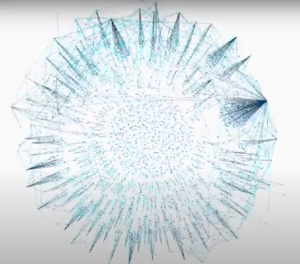Accumulating Social Currency Through SM-F-CoP Engagement (Cont’d)
 Second, today’s world is highly connected through the Internet and most of our stakeholders are on social media and many of them are members of different SM-F-CoPs. As shown in the previous video and also in Figure 1, SM-F-CoPs (shown as clusters of dots) are very dynamic and constantly evolving through interactions with other SM-F-CoPs. Having strong presence on social media would allow digital leaders to network with members of those SM-F-CoPs that their stakeholders are a member of, which provides a great opportunity for digital leaders to use the social currency they have accumulated on social media to influence the stakeholders. This strategy still needs further exploration and validation. But it is reasonable to believe that the more social currency a digital leader accumulates that the stakeholders are aware of, the easier for this digital leader to get trust, buy-ins, and supports from the stakeholders.
Second, today’s world is highly connected through the Internet and most of our stakeholders are on social media and many of them are members of different SM-F-CoPs. As shown in the previous video and also in Figure 1, SM-F-CoPs (shown as clusters of dots) are very dynamic and constantly evolving through interactions with other SM-F-CoPs. Having strong presence on social media would allow digital leaders to network with members of those SM-F-CoPs that their stakeholders are a member of, which provides a great opportunity for digital leaders to use the social currency they have accumulated on social media to influence the stakeholders. This strategy still needs further exploration and validation. But it is reasonable to believe that the more social currency a digital leader accumulates that the stakeholders are aware of, the easier for this digital leader to get trust, buy-ins, and supports from the stakeholders.
The third reason is related to the downsides of social media. Flaming, misinformation, disinformation, conspiracy theories, etc. are some of the terms that have been used to describe the downsides of social media. Flaming refers to “the exchange of emotionally charged, hostile, or insulting messages on computer-mediated communication networks” (Thompsen, 1994, p. 51). Misinformation is defined as a claim that “contradicts or distorts common understandings of verifiable facts” (Guess & Lyons, 2020, p. 10). Disinformation “is meant to deceive” the public by supplying “fake news” to purposefully “disparage opposing viewpoints” (Guess & Lyons, 2020, p. 11). Conspiracy theories emphasize that “a hidden group of powerful individuals exerts control over some aspect of society” (Guess & Lyons, 2020, p.10). All these terms share one commonality – make the public misinterpret or misunderstand the facts and even mislead some to carry out undesired actions. One such example is the information about COVID and COVID vaccine. Real news are mixed with fake and distorted news, which makes it very difficult for both individuals and organizations to make right decisions. Having a strong presence on social media, digital leaders have the opportunity to minimize the aforementioned negative impacts of social media by sharing and communicating real news about themselves and their digital transformation initiatives directly with the world but not through other people’s voices.
Once again, this is an emerging area of interest for digital leaders who are visionary leaders and who are forward thinking. There is an increasing number of individuals and smaller organizations who are venturing into this area to help fill the gap in our knowledge about how digital leaders can capitalize on social media. Below is an example of how a small charity is using social media to accumulate their social currency and build SM-F-CoPs:

